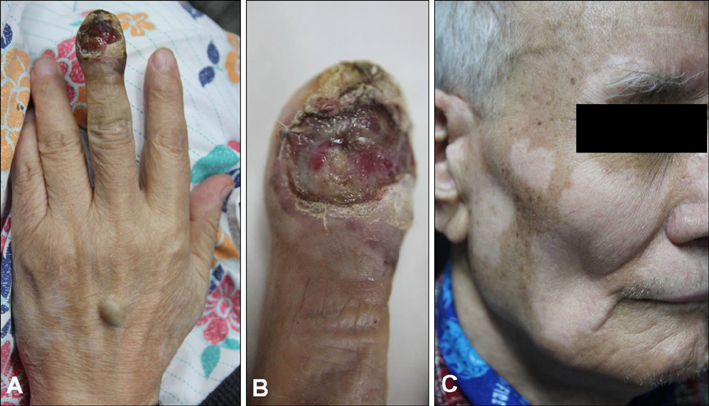Ann Dermatol.
2015 Apr;27(2):201-205. 10.5021/ad.2015.27.2.201.
Amelanotic Acral Melanoma Associated with KIT Mutation and Vitiligo
- Affiliations
-
- 1Department of Dermatology, Chonnam National University Medical School, Gwangju, Korea. sjyun@chonnam.ac.kr
- KMID: 2264812
- DOI: http://doi.org/10.5021/ad.2015.27.2.201
Abstract
- Amelanotic acral melanoma is rare and difficult to diagnose, both clinically and pathologically. KIT mutations are frequently found in acral melanomas and are considered a risk factor for poor prognosis. The presence of vitiligo in melanoma has been reported, and KIT is thought to be partly responsible for the dysfunction and loss of melanocytes observed in vitiligo. We report a case of amelanotic subungual melanoma with multiple metastases that was associated with KIT mutation and vitiligo. An 85-year-old man presented with a 3-year history of a tender erythematous ulcerated tumor on the left third fingertip and developed hypopigmented patches on the face and trunk. Histopathological examination of the ulcerative tumor showed aggregates of tumor cells that were pleomorphic epithelioid cells. Immunohistochemical staining of the tumor cells was positive for S100, HMB45, and c-Kit. Histopathological findings from the hypopigmented patch on the face were consistent with vitiligo. Mutation analysis showed a KIT mutation in exon 17 (Y823D). The patient had metastasis to the brain, liver, bone, and both lungs. The patient refused chemotherapy, and died 3 months after the first visit.
Keyword
MeSH Terms
Figure
Cited by 1 articles
-
Expression of Epidermal c-Kit+ of Vitiligo Lesions Is Related to Responses to Excimer Laser
Oun Jae Park, Ji Su Han, Sang Hyung Lee, Chan-Sik Park, Chong Hyun Won, Mi Woo Lee, Jee Ho Choi, Sung Eun Chang
Ann Dermatol. 2016;28(4):457-463. doi: 10.5021/ad.2016.28.4.457.
Reference
-
1. Pizzichetta MA, Talamini R, Stanganelli I, Puddu P, Bono R, Argenziano G, et al. Amelanotic/hypomelanotic melanoma: clinical and dermoscopic features. Br J Dermatol. 2004; 150:1117–1124.
Article2. Cheung WL, Patel RR, Leonard A, Firoz B, Meehan SA. Amelanotic melanoma: a detailed morphologic analysis with clinicopathologic correlation of 75 cases. J Cutan Pathol. 2012; 39:33–39.
Article3. Kuchelmeister C, Schaumburg-Lever G, Garbe C. Acral cutaneous melanoma in caucasians: clinical features, histopathology and prognosis in 112 patients. Br J Dermatol. 2000; 143:275–280.
Article4. Choi YD, Chun SM, Jin SA, Lee JB, Yun SJ. Amelanotic acral melanomas: clinicopathological, BRAF mutation, and KIT aberration analyses. J Am Acad Dermatol. 2013; 69:700–707.
Article5. Curtin JA, Busam K, Pinkel D, Bastian BC. Somatic activation of KIT in distinct subtypes of melanoma. J Clin Oncol. 2006; 24:4340–4346.
Article6. Jin SA, Chun SM, Choi YD, Kweon SS, Jung ST, Shim HJ, et al. BRAF mutations and KIT aberrations and their clinicopathological correlation in 202 Korean melanomas. J Invest Dermatol. 2013; 133:579–582.
Article7. Kitamura R, Tsukamoto K, Harada K, Shimizu A, Shimada S, Kobayashi T, et al. Mechanisms underlying the dysfunction of melanocytes in vitiligo epidermis: role of SCF/KIT protein interactions and the downstream effector, MITF-M. J Pathol. 2004; 202:463–475.
Article8. Quaglino P, Marenco F, Osella-Abate S, Cappello N, Ortoncelli M, Salomone B, et al. Vitiligo is an independent favourable prognostic factor in stage III and IV metastatic melanoma patients: results from a single-institution hospitalbased observational cohort study. Ann Oncol. 2010; 21:409–414.
Article9. Boasberg PD, Hoon DS, Piro LD, Martin MA, Fujimoto A, Kristedja TS, et al. Enhanced survival associated with vitiligo expression during maintenance biotherapy for metastatic melanoma. J Invest Dermatol. 2006; 126:2658–2663.
Article10. Massi D, Pinzani P, Simi L, Salvianti F, De Giorgi V, Pizzichetta MA, et al. BRAF and KIT somatic mutations are present in amelanotic melanoma. Melanoma Res. 2013; 23:414–419.
Article11. Hong JW, Lee S, Kim DC, Kim KH, Song KH. Prognostic and clinicopathologic associations of BRAF mutation in primary acral lentiginous melanoma in Korean patients: a preliminary study. Ann Dermatol. 2014; 26:195–202.
Article12. Guo J, Si L, Kong Y, Flaherty KT, Xu X, Zhu Y, et al. Phase II, open-label, single-arm trial of imatinib mesylate in patients with metastatic melanoma harboring c-Kit mutation or amplification. J Clin Oncol. 2011; 29:2904–2909.
Article13. Wankowicz-Kalinska A, Le Poole C, van den Wijngaard R, Storkus WJ, Das PK. Melanocyte-specific immune response in melanoma and vitiligo: two faces of the same coin? Pigment Cell Res. 2003; 16:254–260.
Article14. Han H, Yu YY, Wang YH. Imatinib mesylate-induced repigmentation of vitiligo lesions in a patient with recurrent gastrointestinal stromal tumors. J Am Acad Dermatol. 2008; 59:5 Suppl. S80–S83.
Article15. Richards KA, Fukai K, Oiso N, Paller AS. A novel KIT mutation results in piebaldism with progressive depigmentation. J Am Acad Dermatol. 2001; 44:288–292.
Article16. Silver EA, Hofmann AE, Williams D, Srolovitz H, Tahiri Y, Khanna M. Large amelanotic melanoma and vitiligo. Arch Dermatol. 2009; 145:1198–1199.
Article
- Full Text Links
- Actions
-
Cited
- CITED
-
- Close
- Share
- Similar articles
-
- Sensitivity and Usefulness of VE1 Immunohistochemical Staining in Acral Melanomas with BRAF Mutation
- An Ulcerative Amelanotic Melanoma on the Heel
- Polypoid Amelanotic Melanoma on the Thigh
- Immunohistochemistry: sole tool in diagnosing a rare case of primary vaginal amelanotic melanoma
- A Case of Amelanotic Melanoma





